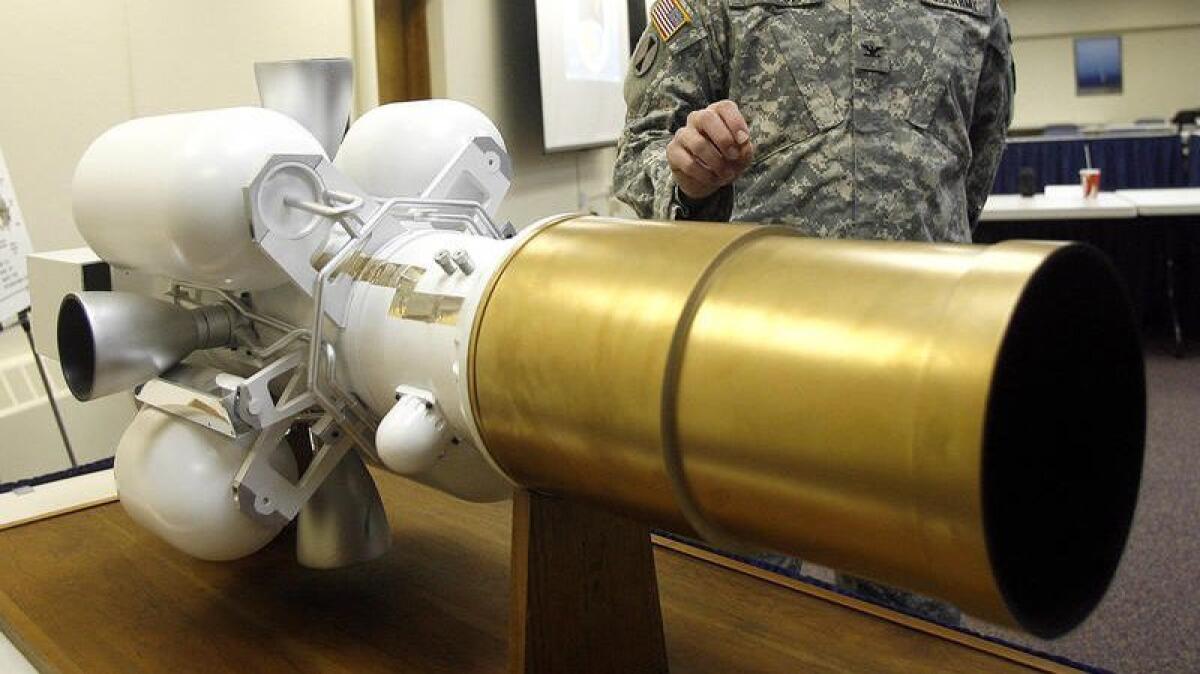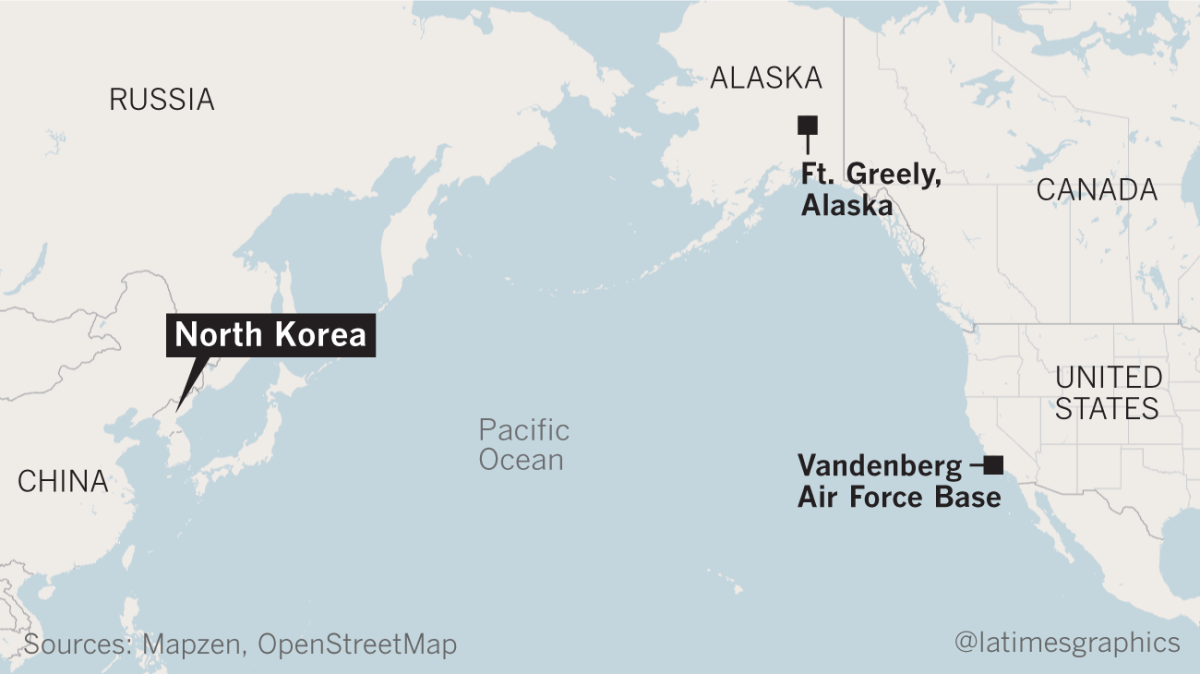Q&A: Can the U.S. defend against a North Korean missile strike?
A flurry of recent missile tests by North Korea has set nerves on edge and stirred fresh concern about whether U.S. defenses could protect Americans against a sneak attack. North Korea has detonated nuclear devices and is trying to develop long-range missiles capable of reaching the United States.
The Pentagon has spent more than $40 billion on the Ground-based Midcourse Defense system — GMD for short. It’s designed specifically to thwart a nuclear strike by North Korea or Iran. Yet there are grave doubts about whether it’s up to the task.
Here is a look at the system’s origins, how it’s supposed to work and the technical problems that have bedeviled it.
What exactly is GMD supposed to do?
It’s designed to defend the United States against a “limited” nuclear attack. That means a strike with a handful of missiles, as opposed to a massive assault of the kind that Russia or China could launch. The United States relies on deterrence — the threat of overwhelming retaliation — to prevent Russia or China from ever unleashing missiles against us. In the case of North Korea or Iran, we would rely on GMD to knock incoming warheads out of the sky.
How would GMD do that?
By intercepting incoming warheads in space, just as they’re about to begin their reentry into the atmosphere. That’s the approximate “midcourse” point in a warhead’s journey from launch pad to target.
What’s an interceptor, and how does it work?
The GMD interceptors are 60-foot-tall, three-stage rockets. Each has a five-foot, 150-pound “kill vehicle” at its tip. In the event of an attack, interceptors would be launched from their underground silos. Once in space, the kill vehicles would separate from their boost rockets and fly independently toward their targets, at speeds up to 4 miles per second.

How many interceptors are there, and where are they based?
There are 37 operational interceptors — four at Vandenberg Air Force Base in Santa Barbara County, Calif., and 33 at Ft. Greely, Alaska.

How would the kill vehicle destroy an incoming warhead? By blowing it up?
The kill vehicles carry no explosives. They’re designed to destroy enemy warheads with kinetic energy, or energy of motion — in other words, by crashing into them.
How would the kill vehicle find the incoming warhead?
Satellites and powerful radars, stationed on land and at sea, track airborne objects. The GMD system receives data from these and other sources and would use it to guide the interceptors. The kill vehicle also has an on-board navigation system to help it zero in on its target.
Why are there doubts about GMD’s reliability?
Intercepting a warhead traveling at hypersonic speed is a supreme technical challenge. It’s been compared to hitting one speeding bullet with another. GMD has not shown that it could do that dependably.
The system has performed poorly in flight tests, and technical problems keep cropping up. In nine simulated attacks since GMD was deployed in 2004, interceptors have failed to take out their targets six times. And the flight tests are much less challenging than an actual attack would be. They’re carefully scripted for success: The operating personnel know ahead of time when mock warheads will be launched, as well as their size, speed and approximate trajectory.
Given that test record, why do Pentagon officials assume the system could knock out all the incoming warheads if an enemy attacked?
They don’t assume that. To the contrary, defense planners assume that four or five GMD interceptors would have to be launched for every incoming warhead to have a good chance of destroying them all, according to current and former government officials. That’s called the “shot doctrine,” and it reflects GMD’s shortcomings. It means that if an adversary launched multiple missiles, our inventory of interceptors could be quickly depleted.
What caused the failures in the GMD test flights?
It’s no single problem — it’s a variety of causes. And that’s what so concerns experts who’ve studied the system. In some cases, divert thrusters were blamed. These are small rocket motors, four of which are attached to each kill vehicle. They’re supposed to fire rapidly to make course corrections and keep the kill vehicle on course once it’s in space and flying on its own. In some tests, the thrusters’ “rough combustion” of fuel was found to have thrown off the kill vehicles’ on-board guidance system.
A lot of time and money was spent redesigning the thrusters to cure this problem. In January 2016, a flight test was initiated from Vandenberg Air Force Base to check out the new thrusters. The Missile Defense Agency and its lead contractors pronounced the test a success. But as The Times later reported, it wasn’t. Partway through the exercise, one of the new thrusters stopped working, and the kill vehicle veered far off-course.
A review overseen by the missile agency found that the thruster “most likely” malfunctioned because of a glitch in the circuit board that powered it. As The Times reported, circuit boards in most of the kill vehicles now in the GMD fleet are vulnerable to the same kind of mishap.
Bottom line: The kill vehicles are tremendously complex machines. Each one has more than 1,000 components. And because of the speed with which they’ve been produced and deployed, no two are identical.
Why the rush?
American scientists had been working on missile defense technology for decades, with the aim of creating a reliable shield for the U.S. homeland. President Clinton, whose administration supported and funded such research, concluded that the technology wasn’t ready for prime time. But his successor, President George W. Bush, had campaigned on a promise to deploy a homeland missile defense system quickly, asserting that the country was in imminent danger of a sneak attack by a “rogue state” such as North Korea or Iran.
In late 2002, Bush ordered the Pentagon to field a “set of missile defense capabilities” by the end of 2004. To speed things along, Defense Secretary Donald H. Rumsfeld exempted the program from the Pentagon’s normal procurement and testing standards.
Analysts trace GMD’s problems to these early decisions to prioritize speed above meticulous engineering and development of proven capabilities.
What kind of marks has GMD gotten from experts?
The Government Accountability Office, a nonpartisan investigative arm of Congress, reported last year that GMD’s test record has been “insufficient to demonstrate that an operationally useful defense capability exists.” In July, a team of missile defense experts who studied GMD for the Union of Concerned Scientists said the system is “simply unable to protect the U.S. public.”
In January, the Pentagon’s Operational Test and Evaluation office, in its annual report on U.S. defense programs, rated GMD’s reliability as “low.” It said the day-to-day “availability,” or readiness, of the system’s interceptors was also “low.” The report added that flight tests had revealed unspecified “new failure modes.”
What does the Missile Defense Agency say?
The agency says it is “absolutely confident” in GMD’s ability to protect the homeland.
Who built the interceptors and other components of GMD?
A handful of defense contractors have produced the system’s major elements. Raytheon Co. has built the kill vehicles and radars. Orbital ATK Inc. has made the boost rockets. Northrop Grumman Corp. has provided the worldwide communications links. Boeing Co. has managed GMD as the government’s prime contractor.
Is there any sign that the Pentagon is reconsidering this entire approach to missile defense?
Some generals have said the cost of an interceptor-based system is unsustainable, and that the U.S. needs to give greater thought to a “left of launch” strategy. That’s military-speak for taking out missiles before they could be launched, as opposed to trying to shoot them out of the sky.
Yet for now the Pentagon is expanding GMD to 44 interceptors, with bipartisan support from Congress. (This is not a Trump initiative; it started under President Obama.) The government is also studying possible sites for a third interceptor field, in the eastern half of the U.S. That would add up to 60 interceptors to the GMD fleet.
Sign up for Essential California
The most important California stories and recommendations in your inbox every morning.
You may occasionally receive promotional content from the Los Angeles Times.








